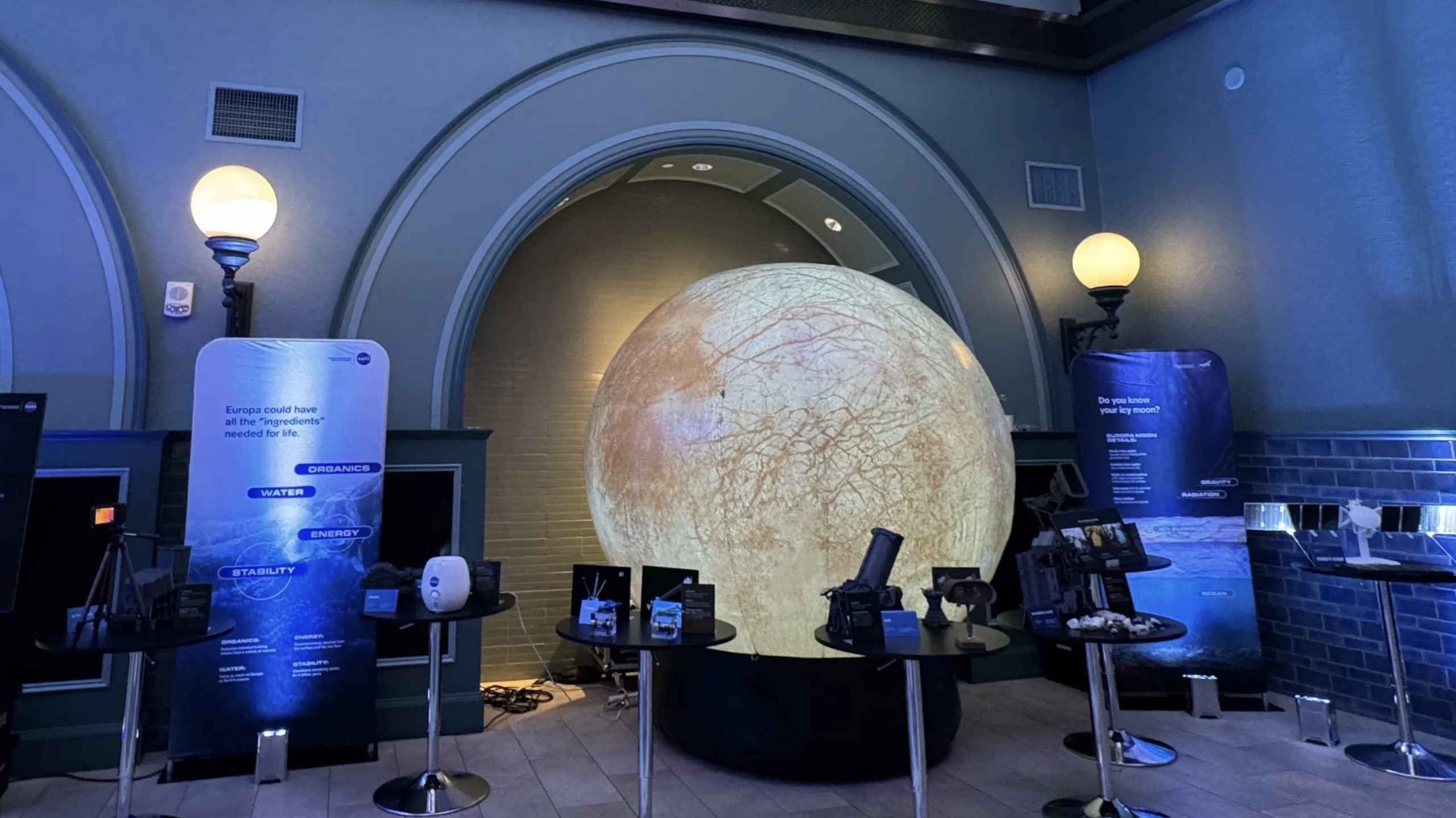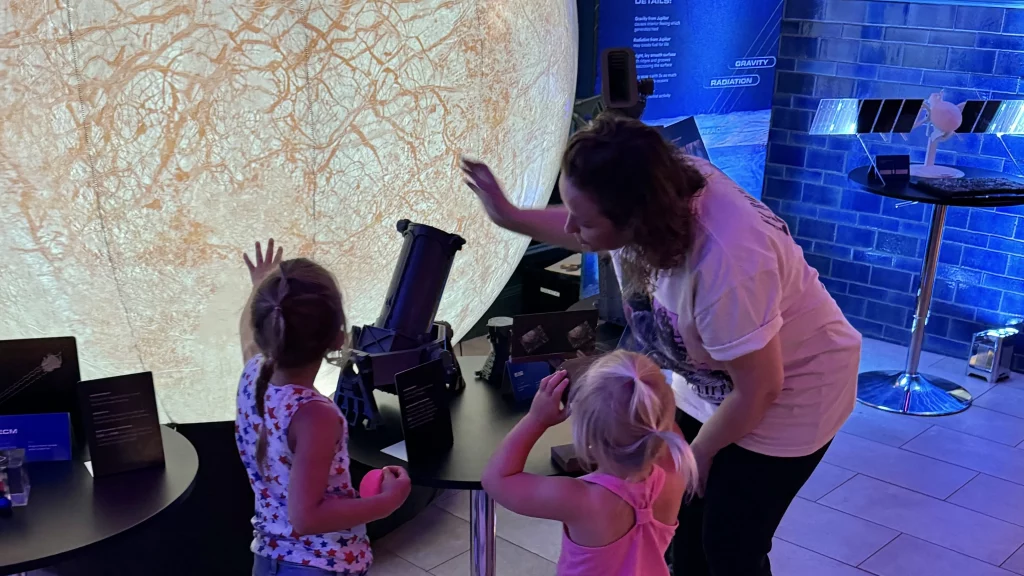Woods Hole Oceanographic Institution to Host NASA’s “Voyage of Europa Clipper: Exploring an Alien Ocean” Exhibit

Gear up for the October 2024 launch of NASA’s Europa Clipper mission, which will uncover the mysteries of Jupiter’s ocean moon Europa, with interactive exhibits, captivating models, and special guest speakers
Photos and video are available here
Woods Hole, Mass. — Woods Hole Oceanographic Institution (WHOI) is thrilled to announce that it will host a special exhibit pop-up, “Voyage of Europa Clipper: Exploring an Alien Ocean,” brought to you by NASA’s Jet Propulsion Laboratory (JPL), from August 9-12, 2024, at the WHOI Village Campus. This captivating exhibit experience, which is free to the public, is part of JPL’s engagement activities leading up to the highly anticipated launch of the Europa Clipper mission in October 2024. The Woods Hole event is the only Northeast stop on the Europa Clipper roadshow schedule.
The Europa Clipper nationwide roadshow is already making its way to six unique locations across the country, including the St. Louis Aquarium at Union Station in St. Louis, MO; the Audubon Aquarium in New Orleans, LA; the Woods Hole Oceanographic Institution in Woods Hole, MA; the California Academy of Sciences in San Francisco, CA; and SEA LIFE Aquarium and Orlando Science Center in Orlando, FL. The choice of aquariums, ocean research centers, and science centers is intended to bridge the aquatic wonders of Earth with the exploration of ocean worlds beyond our planet.
The Europa Clipper spacecraft will arrive at Jupiter in 2030 and will fly by the moon multiple times to collect data that will help scientists determine if it could support life. Europa is considered one of the best candidates to find life beyond Earth because its conditions are very similar to those found here that have given rise to some of the most primitive life forms from which early life likely evolved. “Ocean worlds such as Europa have rocky seafloors, just like Earth’s oceans,” said WHOI senior scientist Chris German. “And we know that, on Earth, wherever there is ocean water in contact with geothermally heated rocks, we find hydrothermal vents, seeps, and other fluid flows that support chemosynthetic microbes and even whole ecosystems.”
To help make sense of data from Europa Clipper, ocean scientists like German have been lending NASA their expertise in hydrothermal vents, sensor development, and ocean modeling. Since 2019, WHOI has been the home of the Network for Ocean Worlds (NOW), one of NASA’s five Astrobiology research coordination networks, which brings together nearly 250 experts and 75 related research projects nationwide, as well as the multi-institutional NASA-funded Exploring Ocean Worlds program. In addition, WHOI senior scientist Julie Huber was a member of the steering committee for the recent decadal survey for Planetary Sciences and Astrobiology from the National Acadamies of Science, Engineering and Medicine, which recommended that NASA pursue two other ocean worlds-related flagship programs to follow from Europa Clipper.
Exhibit Details
- Name: Voyager of Europa Clipper: Exploring an Alien Ocean
- Date: August 9-12, 2024
- Location: Woods Hole Oceanographic Institution Redfield Auditorium, 45 Water St, Woods Hole Village, MA and Ocean Science Discovery Center, 15 School St., Woods Hole, Village, MA
- Time: Friday, August 9, 11:00 a.m. - 5:00pm; Saturday, August 10, 10:00 a.m. - 3:00 p.m. as part of the Woods Hole Science Stroll; and Sunday, August 11, to Monday, August 12, 11:00 a.m. - 5:00 p.m.
For more information, please visit https://woodsholesciencestroll.org/
Exhibit Highlights
- Interactive Experiments: Participate in hands-on experiments that explain the sophisticated instruments onboard the spacecraft.
- Spacecraft and Instrument Models: Explore detailed models of the Europa Clipper spacecraft and its instruments, designed to draw parallels between the life-sustaining oceans on Earth and the subsurface ocean on Europa.
- Inflatable Model of Europa: Get an up-close look at a stunning inflatable model of Europa, one of Jupiter’s moons, known for its subsurface ocean.
- Educational Graphics: Learn about Europa’s intriguing history and its potential for harboring life through engaging and informative graphics.
- Creative Activities: Enjoy activities that blend science with art, designed to excite the public of all ages.

Young children visit NASA's Europa Clipper Roadshow in St. Louis. In this image, two children listen as Heather Doyle, NASA/JPL Solar System Public Engagement and Networks Manager, explains NASA's mission to Jupiter's moon Europa. (Photo Credit: Bill Dunford/©NASA)
Special Speakers
Dr. Cynthia Phillips, Europa Clipper Project Staff Scientist and Science Communications Lead, will provide an insightful talk on the Europa Clipper mission, offering an in-depth look at the science and goals behind this ambitious exploration of Jupiter’s moon Europa.
Dr. Phillips is a planetary geologist at the NASA Jet Propulsion Laboratory in Pasadena, California. She did undergraduate work at Harvard in astrophysics and earned a PhD from the University of Arizona in Planetary Science, where she worked on the Galileo mission to Jupiter and its moons. An expert on image processing and planetary surface processes, Cynthia now works on the Europa Clipper mission, which will launch in October 2024 to study Jupiter's icy moon Europa and its subsurface ocean. Outside of work, Cynthia and her partner have written a dozen books for general audiences on science and other topics, the latest of which is “Astrophysics for Dummies,” and they spend most of their time wrangling their 5 children.
Dr. Phillips will be joined on stage by WHOI senior scientist Dr. Chris German. Dr. German is a senior scientist at WHOI, who’s interest and study of robotics to advance deep ocean exploration together with his expertise in deep sea hydrothermal studies have led to on-going collaborations with NASA’s JPL in advancing plans to investigate ocean worlds of the outer solar system.
About the Europa Clipper Mission
Jupiter’s moon Europa shows strong evidence for an ocean of liquid water beneath its icy crust. Beyond Earth, Europa is considered one of the most promising currently habitable environments in our solar system. Below Europa’s icy surface, evidence suggests there is a global ocean with more water than all of Earth’s oceans combined. Europa could have all the “ingredients” needed for life as we know it: water, organic, energy, and stability.
NASA's Europa Clipper spacecraft will perform approximately 50 close flybys of the moon, gathering detailed measurements to investigate whether the moon could have conditions suitable for life. Europa Clipper is not a life detection mission – its main science goal is to determine whether there are places below Europa’s surface that could support life. Europa Clipper’s three main science objectives are to determine the thickness of the moon’s icy shell and its surface interactions with the ocean below, to investigate its composition, and to characterize its geology. The mission’s detailed exploration of Europa will help scientists better understand the astrobiological potential for habitable worlds beyond our planet.
Managed by Caltech in Pasadena, California, JPL leads the development of the Europa Clipper mission in partnership with the Johns Hopkins Applied Physics Laboratory (APL) for NASA’s Science Mission Directorate in Washington.
To learn more about the mission, visit europa.nasa.gov.
###
About Woods Hole Oceanographic Institution
The Woods Hole Oceanographic Institution (WHOI) is a private, non-profit organization on Cape Cod, Massachusetts, dedicated to marine research, engineering, and higher education. Established in 1930, its primary mission is to understand the ocean and its interaction with the Earth as a whole, and to communicate an understanding of the ocean’s role in the changing global environment. WHOI’s pioneering discoveries stem from an ideal combination of science and engineering—one that has made it one of the most trusted and technically advanced leaders in basic and applied ocean research and exploration anywhere. WHOI is known for its multidisciplinary approach, superior ship operations, and unparalleled deep-sea robotics capabilities. We play a leading role in ocean observation and operate the most extensive suite of data-gathering platforms in the world. Top scientists, engineers, and students collaborate on more than 800 concurrent projects worldwide—both above and below the waves—pushing the boundaries of knowledge and possibility. For more information, please visit www.whoi.edu
For more information on the Ocean Worlds project, visit: https://oceanworlds.whoi.edu/
Gretchen McCartney
NASA’s Jet Propulsion Laboratory
818-393-6215
gretchen.p.mccartney@jpl.nasa.gov
Suzanne Pelisson
Woods Hole Oceanographic Institution
973-801-6223
Ken Kostel
Woods Hole Oceanographic Institution
917-743-3454
KKostel@WHOI.edu
